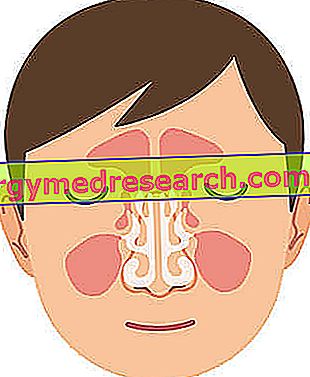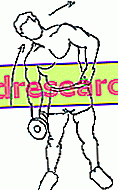Generality
The nasal septum is the lamina that divides, without the possibility of mutual communication, the two nasal cavities and the two nasal nostrils.
The nasal septum comprises a bone component and a cartilaginous component.

Coated with eyelid respiratory mucosa, the nasal septum is richly vascularized and innervated.
His musculature, on the other hand, is small and includes a single muscle: the so-called depressor muscle of the nasal septum.
The nasal septum can be the victim of pathological deviations. In general, the pathological deviations of the nasal septum are consequences of traumatic events.
Brief anatomical reference of the nose
The nose is the prominence located at the center of the face, between the two eyes and partly between the two cheeks, which provides the sense of smell and which represents the main entry of the respiratory tract.
Its structure is quite complex and includes elements of bone and cartilage, blood vessels, lymphatic vessels and important nerve endings.
Externally, the nose has a characteristic pyramid shape, in which it is possible to recognize at least 5 anatomical reference areas: the nasal root, the nasal bridge, the nasal back, the two nasal wings and the nasal tip.
Internally, the nose corresponds to the two nasal cavities; the latter are two empty spaces deriving from the particular conformation of some bones of the skull (including the ethmoid bone, the vomer, the palatine bones and the maxillary bones).
What is the nasal septum?
The nasal septum is the osteo-cartilaginous lamina that separates, more or less equally and without the possibility of mutual communication, the two nasal cavities and the two nostrils (or nasal nostrils ).
It is therefore due to the presence of the nasal septum that the anatomists speak of a nostril and a nasal cavity of the right and of a nostril and a left nasal cavity.
In an ideal depiction of the nose and the human face, the nasal septum appears as a linear structure. In reality, however, in many people, it presents slight congenital deviations (that is, present since birth), which are generally without consequences on the health of the persons directly involved.
Meaning of the adjective "osteo-cartilaginous"
For readers who were not aware of it, an anatomical element is called osteo-cartilaginous, when it presents bone components and cartilaginous components (ie composed of cartilage).
OTHER DEFINITION
According to another definition of nasal septum, the latter is the osteo-cartilaginous lamina that constitutes the medial wall of the nasal cavities.
In anatomy, the term "medial" means "near" or "closer" to the sagittal plane, ie the anteroposterior division of the human body, from which two equal and symmetrical halves are derived.
"Mediale" is opposed to "lateral", which, in fact, means "far" or "farther" from the sagittal plane.
Anatomy
In the nasal septum, the bone component represents the postero-inferior portion, while the cartilaginous component represents the antero-inferior portion.
As regards the bone component of the nasal septum, this includes:
- The perpendicular lamina of the ethmoid (or simply ethmoid) bone . The ethmoid is an unequal bone of the skull, due to the precision of the splanchocranium . It is important not only in the formation of the nasal septum, but also because it constitutes the superior turbinates, the middle turbinates and the lamina cribrosa ;
- Bone plowshares (or simply plowshares). The plowshare is another uneven bone element of the splanchocranium;
- The so-called nasal ridges of palatine bones and jaw bones .
As for the cartilaginous component of the nasal septum, this consists of:
- The so-called cartilage of the septum (or septal cartilage or quadrilateral cartilage );
- The major alar cartilages (or lower lateral cartilages ) and the lesser wing cartilages ;
- The columella .
The images below are very important to understand the exact location of the various bone and cartilaginous elements that make up the nasal septum. For this reason, careful vision is recommended.

Figure : skull bones. The position of the vomer, the ethmoid bone, the maxillary bones and the nasal bones is particularly noteworthy.

Figure : cartilaginous components of the nasal septum

Figure : bone components that make up the nasal septum.
MEMBRANOSA PORTION
Although the bony and cartilaginous portions represent the preponderant part of the nasal septum, the latter also includes a part that is neither of bone nature nor of cartilaginous nature. The anatomists define this particular part with the term membranous portion or membranous part or membranous septum .
The membranous portion consists of a double layer of skin, mixed with adipose tissue, and takes place between the cartilage of the septum and the columella.
MICROSCOPIC ANATOMY
Inside the nasal cavities, the nasal septum is lined with a respiratory lining mucosa . The eyelid respiratory mucosa is the epithelium that distinguishes the respiratory tract.
JOINTS OF THE NASAL SECTOR
The nasal septum is articulated with: the rostrum of the sphenoid bone, above; the nasal bones and the nasal spine of the frontal bone, anterioro-superiorly; finally, the anterior nasal spine of the jaw, below.
The joints that the nasal septum forms with the bones and the aforementioned bony portions are fixed, therefore without mobility.
vascularization
The task of supplying the nasal septum with oxygenated blood belongs to 5 arteries, which are:
- The anterior ethmoid artery and the posterior ethmoid artery . They are two branches of the ophthalmic artery, which is, in turn, a branch of the internal carotid artery ;
- The upper labial artery . It is a branch of the facial artery, which derives from the external carotid artery;
- The sphenopalatine artery . It is a branch of the maxillary artery, which also originates from the aforementioned external carotid artery;
- The major palatine artery . It is another branch of the maxillary artery.
In the antero-inferior portion of the nasal septum, these 5 arterial vessels join one another (in technical jargon, it is said that they anastomyse), giving rise to an important arterial plexus known as the Kiesselbach plexus or Kiesselbach area .
Regarding the drainage of venous blood, this affects several veins, which are specifically: the sphenopalatine vein, the anterior and posterior ethmoid veins, the anterior facial vein and cerebral veins.
MUSCLES
The only muscle in the human body that establishes relationships with the nasal septum and influences it, albeit only to a limited extent, is the so-called nasal septum depressor muscle .
The depressor muscle of the nasal septum is an even muscle element, which originates at the level of the incisive fossa of the maxillary bone and ends at the lower part of the nasal septum.
From a functional point of view, it serves to:
- Depress, in the sense of lowering, the nasal septum e
- Assist the wing part of the nasal muscle, in its dilation of the lateral portions of the nose (the so-called nasal wings).
INNERVATION
The innervation of the nasal septum is due to two sub-branches of the trigeminal nerve ( V cranial nerve ). These sub-branches are the nasopalatine nerve and the anterior ethmoidal nerve .
The nasopalatine nerve derives from the maxillary nerve, while the anterior ethmoid nerve is a derivation of the nasociliary nerve, which is itself a derivation of the ophthalmic nerve .
It is recalled that the maxillary nerve and the ophthalmic nerve constitute, together with the mandibular nerve, the three main divisions of the trigeminal nerve.
Development
In humans, the nose and its structures (including the nasal septum) begin to form starting from the fourth (IV) week of gestation.
Initially, the nasal septum is an exclusively cartilaginous structure. Its bone component, in fact, begins to appear around the eighth (VIII) week of intrauterine way: the ossification process gives life first to the perpendicular lamina of the ethmoid bone, then to the vomer and finally to the nasal ridges of the palatine and maxillary bones . The process in question depends on two ossification centers .
The formation of the nasal septum is quite long times. In fact, it ends several years after birth, usually at puberty.
Functions
In addition to serving as a dividing element of the two nasal cavities, the nasal septum is an important support structure for the nose and, thanks to its coating of eyelid respiratory mucosa, it contributes significantly to the heating and purification of the inhaled air.
diseases
The nasal septum may undergo pathological deviations .
In most cases, the pathological deviations of the nasal septum are a consequence of traumatic events to the detriment of the nose (eg motor vehicle accidents, domestic accidents, sports injuries, etc.).
The presence of a serious pathological deviation of the nasal septum - a condition that takes the name of a deviated nasal septum - is responsible for various disorders, including: obstruction of one or both nostrils, epistaxis, facial pain, respiratory problems in sleep, dry mouth and sense of pressure to one or both nostrils.
The only way to correct a deviation of the nasal septum is through surgery, known as septoplasty .
The use of septoplasty is foreseen only when the presence of the deviated nasal septum is incompatible with the performance of a normal life.
Congenital deviations of the nasal septum and septoplasty
Sometimes, doctors resort to septoplasty even in the presence of congenital deviations of the nasal septum. This happens when the nasal septum deviated at birth involves symptoms and complications.



